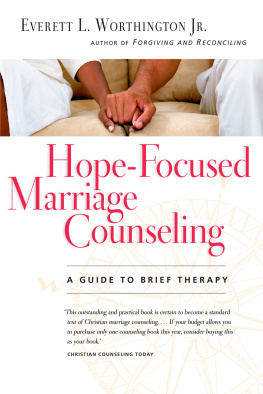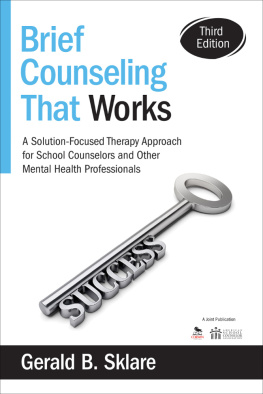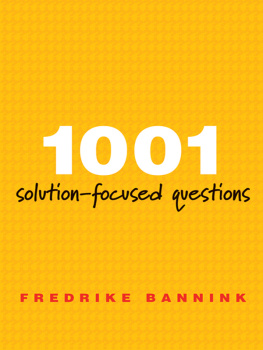The Power
of
Groups
The Power
of
Groups
Solution-Focused Group
Counseling in Schools
LESLIE COOLEY

Copyright 2009 by Corwin
All rights reserved. When forms and sample documents are included, their use is authorized only by educators, local school sites, and/or noncommercial or nonprofit entities that have purchased the book. Except for that usage, no part of this book may be reproduced or utilized in any form or by any means, electronic or mechanical, including photocopying, recording, or by any information storage and retrieval system, without permission in writing from the publisher.
For information:
 | Corwin
A SAGE Company
2455 Teller Road
Thousand Oaks, California 91320
(800) 233-9936
Fax: (800) 417-2466
www.corwinpress.com | SAGE India Pvt. Ltd.
B 1/I 1 Mohan Cooperative
Industrial Area
Mathura Road,
New Delhi 110 044
India |
SAGE Ltd.
1 Olivers Yard
55 City Road
London EC1Y 1SP
United Kingdom | SAGE Asia-Pacific Pte. Ltd.
33 Pekin Street #02-01
Far East Square
Singapore 048763 |
Printed in the United States of America.
Library of Congress Cataloging-in-Publication Data
Cooley, Leslie.
The power of groups: solution-focused group counseling in schools/Leslie Cooley.
p. cm.
Includes bibliographical references and index.
ISBN 978-1-4129-7096-9 (cloth)
ISBN 978-1-4129-7097-6 (pbk.)
1. Group guidance in education. 2. School psychology. I. Title.
| LB1027.55.C68 2009 |
| 371.4047dc22 | 2008053487 |
This book is printed on acid-free paper.
09 10 11 12 13 10 9 8 7 6 5 4 3 2 1
| Acquisitions Editor: | Jessica Allan |
| Editorial Assistant: | Joanna Coelho |
| Production Editor: | Libby Larson |
| Copy Editor: | Jenifer Dill |
| Typesetter: | C&M Digitals (P) Ltd. |
| Proofreader: | Theresa Kay |
| Indexer: | Terri Corry |
| Cover Designer: | Michael Dubowe |
Contents
Preface
WHY SHOULD YOU READ THIS BOOK?
You should read this book if you
- would like to learn how to be an effective group leader using a solution-focused approach to group counseling,
- are just beginning your career and would like to learn processes that will make setting up and leading groups much easier,
- are an experienced leader and would like to increase the probability that your group counseling meetings go as planned, perhaps even exceeding your expectations,
- would like to avoid spending time ensnared in the many pitfalls common to inexperienced group leaders,
- want ideas on handling situations that trip you up,
- are looking for new strategies that will help you do what you set out to do in the first placepositively impact the lives of students.
In addition to teaching new skills, the lessons learned in this book will likely make leading school groups more enjoyable; building on strengths and bringing out the best in students is inherently rewarding. If there has been a lag between the last group you led and the next one you will lead, this book will introduce some exciting new ideas and refresh some helpful old ones. The net effect will be an increase in confidence in your skills.
For both new and experienced practitioners, this book will be a valuable resourcenot as a book of activities but, rather, as a companion book to your favorite group counseling or activity books. You will learn to modify activities using a solution-focused approach as the foundation, to create more lively and engaging group meetings, and most important, to promote change in the lives of the students you serve.
WHAT IS HAPPENING TO GROUP COUNSELING?
In 1984, 93 percent of public high schools offered group guidance/counseling sessions; in 2002, that number dropped to 85 percent (Parsad, Alexander, Farris, & Hudson, 2004). What is happening? When practitioners were surveyed, the lack of sufficient time for group counseling was the most frequent reason cited (Steen, Bauman, & Smith, 2007). Counselors and others who have offered groups in the past now have multiple obligations, including increased involvement with standardized testing, special education responsibilities, and dealing with behavior management issues.
It is, however, possible that the time crunch cited by counselors is masking other issues. LaFountains (1993) statewide survey of school counselors examined the relationship between how counselors spend their time and their level of job stress. Job burnout was reported when counselors were asked to perform duties for which they were inadequately trained. One of the areas cited by counselors as an area of inadequate training was group counseling.
Inadequate training in the face of a professional expectation can leave the practitioner in a demoralized position. Failed attempts at group counseling based on weak training can leave the practitioner scrambling for a more familiar and meaningful way to contribute in a school setting. If this accurately describes your experience, this book is a good start at reversing the above trend.
WHY IS THIS BOOK DIFFERENT FROM OTHER BOOKS ON GROUP COUNSELING?
This book specifically addresses two areas of group counseling: (a) how to successfully plan groups in a school setting and (b) how to lead school counseling groups using a solution-focused approach. While books on general group counseling abound, most are collections of group activities and do not have a theoretical orientation or counseling model as a foundation. The typical group counseling book focuses on getting students to talk about their issues, process whats happening, and share feelings. In contrast, a solution-focused counseling group is strength based: The focus is on goals, what the student wants to do differently, and personal resources. The strategies of a solution-focused approach are consistent with current research on creating change. There is perhaps no better antidote to job burnout than helping to create a positive change in the lives of the students with whom we work.
WHAT WILL I FIND IN THIS BOOK?
An examination of the process of change is a good starting point for any book on counseling. Positive change is, after all, the central issue of all counseling. , the techniques and strategies of a solution-focused approach are discussed in the context of group counseling.
The second half of the book has a practical, how-to focus. is a reflection and conclusion. The reader is invited to consider the discussions throughout the book in relation to professional identity and delivering the best possible service to students in the schools.
While getting a counseling group up and running can be challenging, the rewards for both the leader and the participants can be substantial. Most practitioners have some choices about how to serve students. This book will make it easier for you to choose group counseling more often, and it will make you happier with your choice!
Acknowledgments
I am indebted to California State University, Sacramento, for a sabbatical in the spring of 2008. This was the time I needed to write this book, which had been brewing for years.
Next page











